This User Guide is written as general guide on how to set up the Cisco 6851 to work with PBXware.
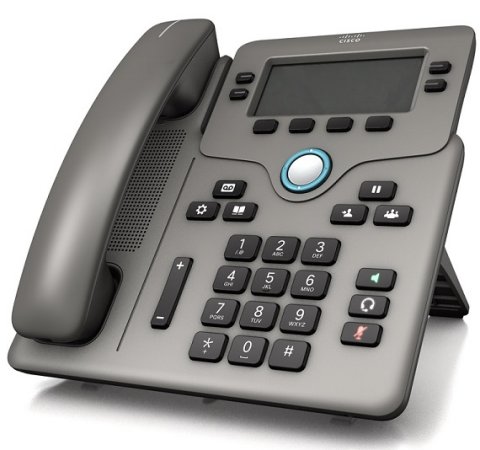
¶ Video Tutorial
Video tutorial explaining Auto Provisioning setup for Cisco Phone on PBXware 4.
Video tutorial explaining Auto Provisioning setup for Cisco Phone on PBXware 5.
¶ Requirements
¶ Identify Cisco 6851 device
- To start and successfully complete registration of your Cisco device you need to know which device model you will setup.
- From the back of each Cisco device there are exact model information that you should check. Although different device models can have exactly the same requirements and installation procedure, device models can also have significantly different requirements and installation procedure, so that ignorance of your own model may result in the inability to successfully set up your device.
¶ Device firmware
- Make sure that your device is loaded with appropriate firmware version, 11.0.2.
- For Cisco 6851 press menu button, then type 61 to check the version of the software.
¶ DHCP server
- Fully configured and operational DHCP server.
¶ PBXware version
- In order to find out the PBXware version, please login to PBXware and navigate to Settings: About. On the top of "About" page is a code similar to this one "PBXware Edition: Business, Release: 4.1.4 (041373f), Running: 1.4.24-gc-75ee203", where "Release" denotes the exact version of your PBXware.
¶ Installation
This chapter describes how to install and connect the device to the electrical power and data network as well as how to apply factory settings.
The following topics are covered:
- Power adapter
- Factory Settings
¶ Power Adapter
1. Connect the Network and Power
- Connect the DC plug on the power adapter to the DC port on the device and connect the other end of the power adapter into an electrical power outlet.
- Connect the ethernet cable between the Internet port on the device and the network port on a router or switch to access LAN.
¶ IP Address
1. Find out your Cisco 6851 IP Address
- For Cisco 6851, press settings button then type 62 to check ip address of the phone.
¶ Factory Settings
1. Reset to factory settings
This step is not required for out-of-the-box devices, however, if the device has been already used then it is a must.
- For Cisco 6851, press settings button then type 56. Confirm with OK on prompt to factory reset the phone.
- Wait sometime prior for device to reboot.
NOTE: Do not unplug or remove power to the device while it is updating firmware and configurations.
¶ Registering Device
This chapter describes how to identify Cisco 6851 phone model, requirements that must be met and how to register the device using manual configuration or auto provisioning.
The following topics are covered:
- Manual Configuration
- Auto Provisioning
¶ Manual Configuration
This chapter describes how to set UAD settings, create PBXware extension and register the device.
The following topics are covered:
- UAD Settings
- Creating Extension
- Registering Device
¶ UAD Settings
1. Login to PBXware web administration interface
- Open a new browser window and enter the IP address in order to access the PBXware web administration login screen. Example: http://192.168.1.10
- Login to PBXware with your e-mail address and password.
2. UAD settings
- Navigate to Settings:UAD.
- Make sure Cisco 6851 UAD is enabled. To check the UAD status click on the edit icon corresponding to your Cisco phone.
- Make sure Status is set to Active, Auto provisioning is set to No, and DHCP is set to Yes.
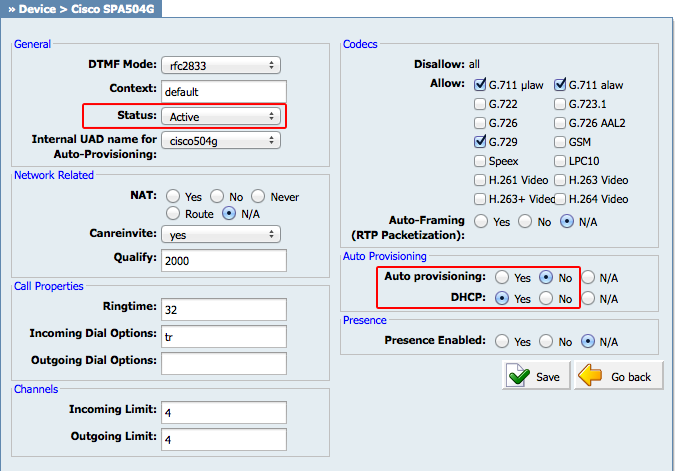
- Click on the Save button to save changes.
¶ Creating Extension
1. Add Extension
- Navigate to Extensions. Click on Add Extension.
- The standard options window will be shown below.
- Select Cisco 6851 phone model from the UAD select box.
- Select Location: Local or Remote.
Local is for all extensions registered on the LAN and Remote is for all extensions registered from remote networks, WAN, Internet etc.
- Click on the Next step button.
2. Extension values
Enter values into the required field text boxes.
REQUIRED FIELDS:
- Name
Enter a name for the extension being created. Example: John Smith.
Enter the e-mail address associated with this extension. This e-mail address will receive all system notification messages. Example: john.smith@bicomsystems.com
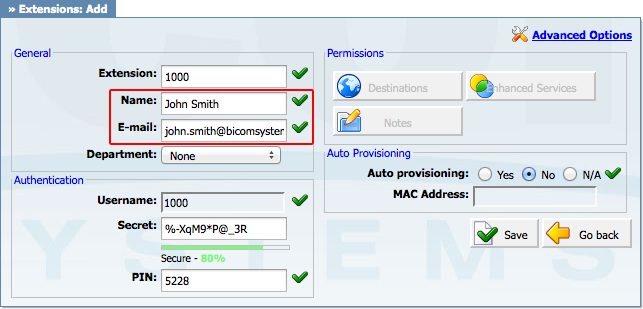
- Click on the Save button.
- Optionally, click on the Save & E-mail button. Account details will be sent to the e-mail address associated with this extension.
OPTIONAL FIELDS
- Extension
An auto-generated extension number based on the next available sequential number. An extension value can be changed. Example: 1003.
- Secret
A secret value associated with the UAD is auto-generated in order to allow the UAD to successfully register with the system. The secret value can be changed, however it is STRONGLY recommended not to change the system generated value to a simple value like "1234" or "1003" etc.
- PIN
An auto-generated PIN will allow access to voicemail and online self-care.
¶ Registering Phone
This chapter describes how to register Cisco 6851 device using Hostname or IP Address.
¶ Hostname or IP Address
1. Login to device web administration interface
- Open a new browser window and enter your phone IP address in order to access the device web administration interface login screen. Example: http://192.168.1.22.
- Click on Admin Login in the top right corner of the administration interface.
- Click on Advanced in the top right corner of the administration interface.
- Click on Voice on the main menu.
- Click on Ext 1 on the sub menu.
- Enter or set the following details into the respective fields.
REQUIRED FIELDS:
- Proxy (Proxy and Registration section)
Enter the Hostname or IP Address of the PBXware.
- Example for Hostname: voip.bicomsystems.com
- Example for IP Address: 192.168.1.10
- User ID (Subscriber Information section)
PBXware extension number. Example: 1003.
- Password
The Secret of the extension as received in the e-mail associated with this extension. Example: _%Z4M3*Ts9y7. A password is generated automatically for each newly created extension.
- Navigate down to "Dial Plan" section. Clear the Dial Plan field, then copy and paste the following value.
(*x.|**x.|*xx|[3469]11|0|00|[2-9]xxxxxx|1xxx[2-9]xxxxxx|xxxxxxxxxxxx.)
- Click on the Submit button.
- You'll have to wait sometime prior for the device to reboot. If everything is done as above described, you should have successfully registered your device to PBXware.
¶ Auto Provisioning
This chapter describes how to set UAD settings, create PBXware extension and register the device using DHCP or Static IP address.
The following topics are covered:
- UAD Settings
- Creating Extension
- Registering Device
¶ UAD Settings
1. Login to PBXware web administration interface
- Open a new browser window and enter the IP address in order to access the PBXware web administration login screen. Example: http://192.168.1.10.
- Login to PBXware with your e-mail address and password.
2. UAD settings
- Navigate to Settings:UAD.
- Make sure Cisco 6851 UAD is enabled. To check the UAD status click on the edit icon corresponding to your Cisco phone.
- Make sure Status is set to Active, Auto provisioning is set to Yes, and DHCP is set to Yes.
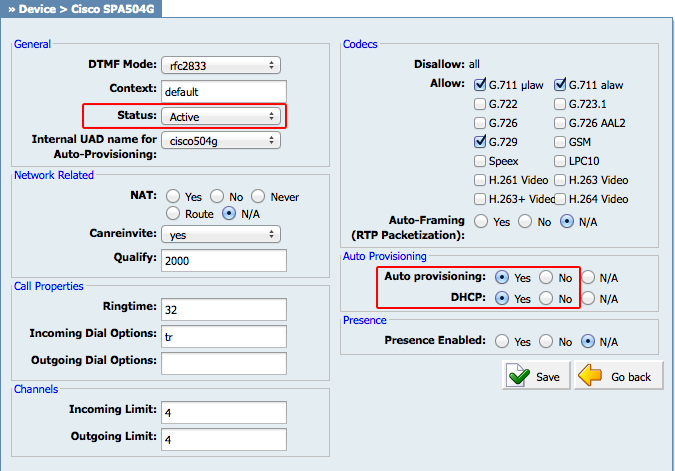
- Click on the Save button to save changes.
¶ Creating Extension
1. Add Extension
- Navigate to Extensions. Click on Add Extension.
- The standard options window will be shown below.
- Select Cisco 6851 device model from the UAD select box.
- Select Location: Local or Remote.
Local is for all extensions registered on the LAN and Remote is for all extensions registered from remote networks, WAN, Internet etc.
- Click on the Next step button.
2. Extension values
Enter values into the required field text boxes.
REQUIRED FIELDS:
- Name
Enter a name for the extension being created. Example: John Smith.
Enter the e-mail address associated with this extension. This e-mail address will receive all system notification messages. Example: john.smith@bicomsystems.com
- Auto Provisioning
Set to Yes.
- MAC Address
Enter Cisco 6851 device MAC address. Example: 0002FDFF1536. MAC address can be found at the back of the phone.
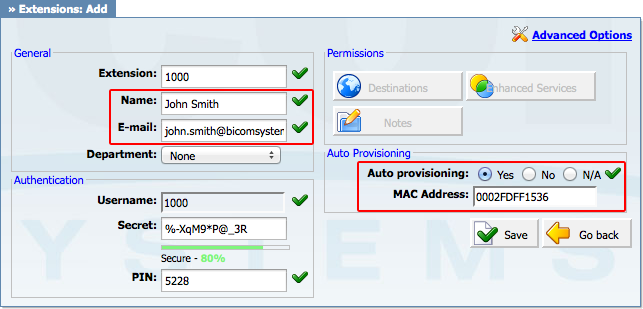
- Click on the Save button.
¶ Registering Phone
This chapter describes how to register Cisco 6851 device using DHCP, TFTP or HTTP.
The following topics are covered:
- DHCP
- TFTP or HTTP
¶ DHCP
1. Configure DHCP
- Make sure your DHCP router is configured to use option 66 to automatically instruct devices with the URL for auto provisioning. For more information refer to your router documentation or contact your network administrator.
2. Device first boot or user initiated reboot
Auto provisioning process will start during device first boot or after reboot process has been initiated by user. DHCP server will instruct the device where from to pickup appropriate configuration file. If everything is done as above described, you should have successfully registered your device to PBXware.
¶ TFTP or HTTP
1. Login to device web administration interface
- Open a new browser window and enter your device IP address in order to access the device web administration interface login screen. Example: http://192.168.1.22
- Click on Admin Login in the top right corner of the administration interface.
- Click on Advanced in the top right corner of the administration interface.
- Click on Voice at the top navigation menu.
- Click on Provisioning sub menu.
- You can use TFTP or HTTP protocols in order to Auto Provision your Cisco SPA device.
- Choose which protocol you want to use:
- TFTP
- HTTP
¶ TFTP
- In the Profile Rule field enter tftp:// followed by Hostname or IP Address, followed then by /$MA.cfg.
- Example for Hostname: tftp://voip.bicomsystems.com/$MA.cfg
- Example for IP Address: tftp://10.1.70.150/$MA.cfg
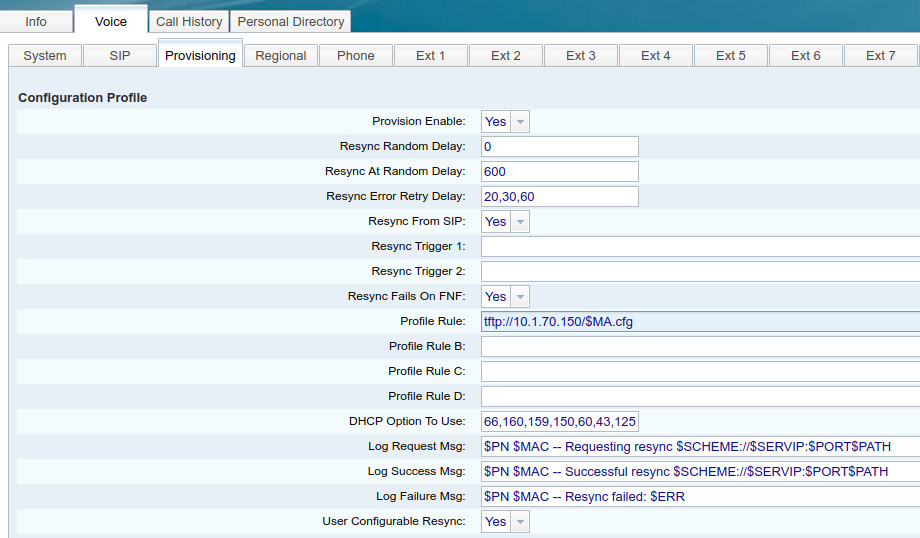
- Click on Submit and wait 35 seconds. The phone may reboot.
- Auto provisioning process will start during device reboot process, device will pickup appropriate configuration file from PBXware. If everything is done as above described, you should have successfully registered your device to PBXware.
¶ HTTP
This chapter describes how to use HTTP protocol in order to register Cisco SPA device. NOTE: Your PBXware needs to be configured correctly for HTTP to work. Please make sure that HTTP username and HTTP passwords are set in Auto provisioning section in Settings -> Servers/Tenants -> Server/Tenant name. Contact your PBXware administrator. Bicom Systems can provide service to set up this for you.
- In the Profile Rule field enter:
- Example for Hostname using HTTP: [--uid username --pwd password]http://voip.bicomsystems.com/prov/$MA.cfg
- Example for IP Address using HTTP: [--uid username --pwd password]http://10.1.70.150/prov/$MA.cfg
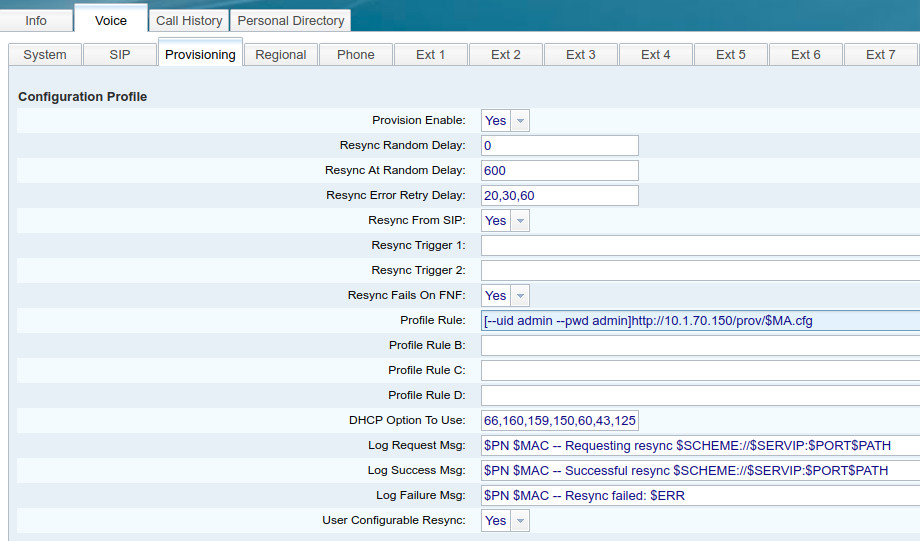
- Make sure you replace Hostname or IP Address from this example with your PBXware Hostname or IP address.
- Make sure to replace http-username and http-password with Your server http username and password.
- Click on Submit and wait 35 seconds. The phone may reboot.
- Auto provisioning process will start during phone reboot process, phone will pickup appropriate configuration file from PBXware. If everything is done as above described, you should have successfully registered your phone to PBXware.
¶ Configure BLF
This chapter describes how to configure BLF (Busy Lamp Field) for Cisco 6851.
¶ Etension Settings
Login to PBXware web administration interface.
- Open a new browser window and enter the IP address in order to access the PBXware web administration login page. Example: http://192.168.1.10.
- Login to PBXware with your e-mail address and password.
Edit extension.
- On the Extensions page click on the edit icon corresponding to your extension.
- Click on Advanced Options button.
- Navigate down to the Auto Provisioning and Presence group of settings.
- Make sure Auto Provisioning is set to Yes.
- Make sure Presence is set to "Yes".
- Click on the Save button to save changes.
- Click on Enhanced services.
- Click on Directory / BLF List check box and click on Save button in order to enable this feature.
- Click on Directory / BLF List Edit button.
- Enter user extension number and click on the BLF check box.
- Click on Save button.